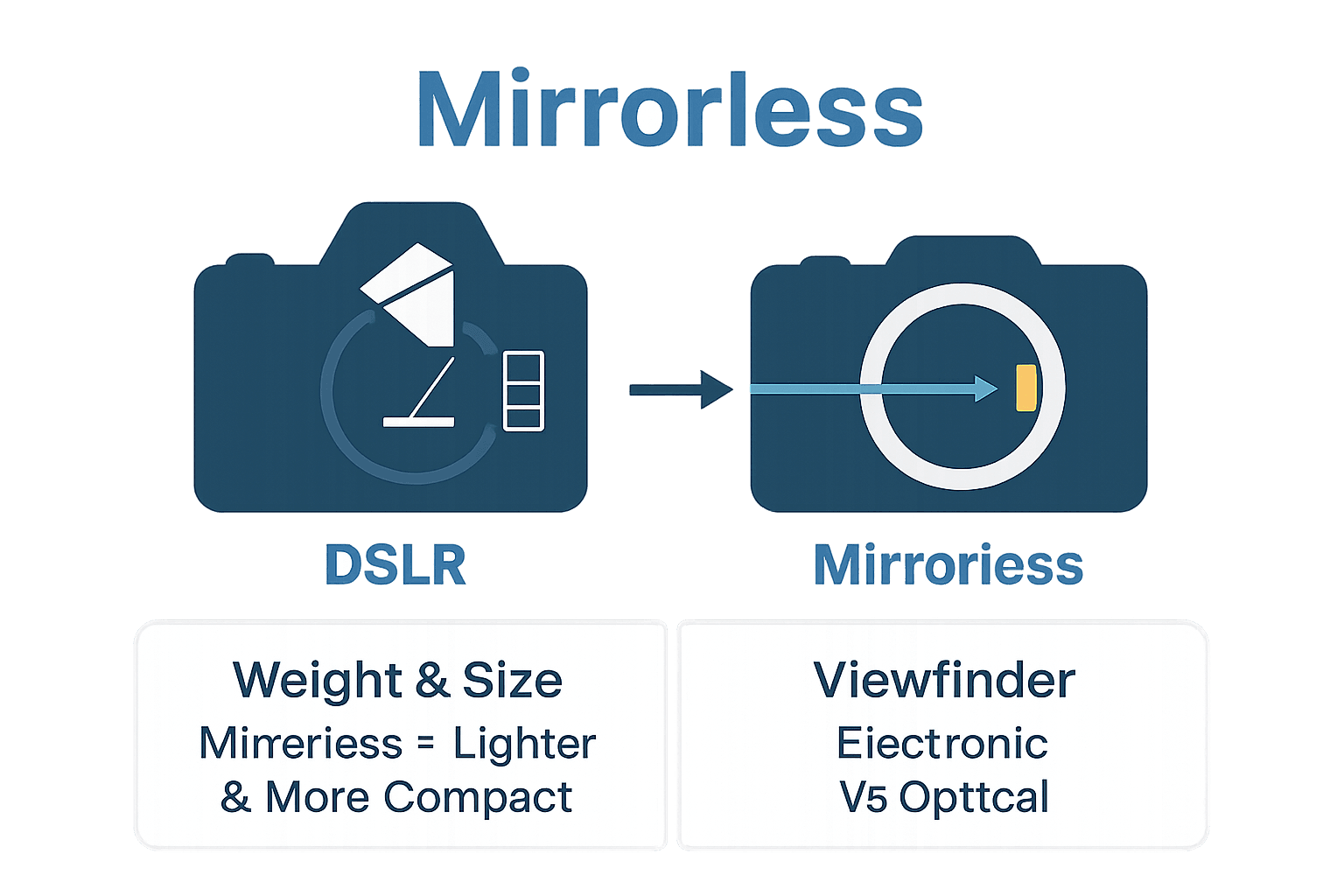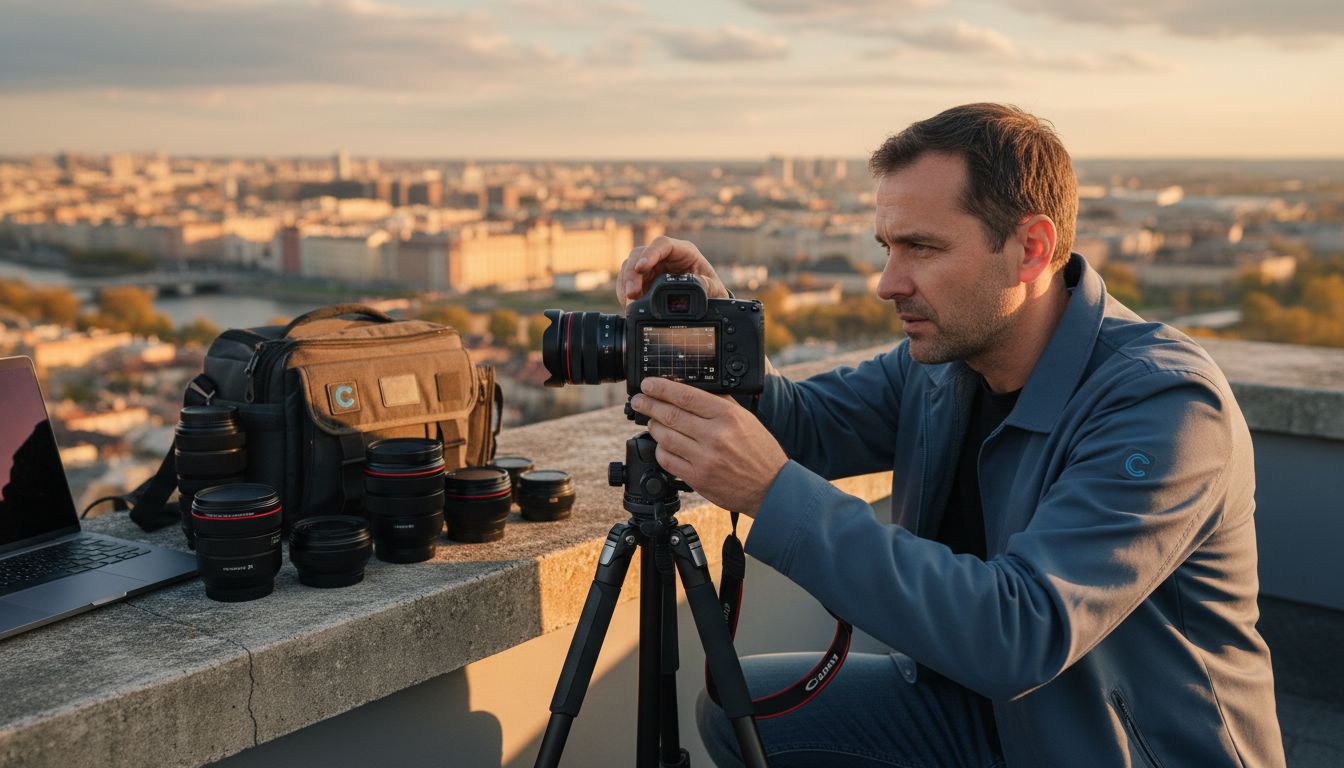Table of Contents
- Key Takeaways
- Defining Mirrorless Cameras and Core Concepts
- Key Features of Mirrorless Camera Systems
- Types of Mirrorless Cameras Explained
- How Mirrorless Cameras Work in Practice
- Mirrorless vs DSLR: Key Differences Compared
- Common Mistakes When Choosing Mirrorless Cameras
- Unlock Your Potential With the Right Mirrorless Camera
- Frequently Asked Questions
- Recommended
This blog post may contain affiliate links. As an Amazon Associate I earn from qualifying purchases.
Nearly 60 percent of american photographers now choose mirrorless cameras over traditional DSLRs, signaling a major shift in how creative professionals work. As digital technology continues to evolve, understanding what sets these cameras apart has become an important part of picking the right equipment. This guide cuts through the confusion to reveal what truly matters when it comes to mirrorless technology, empowering you to make smarter choices for your own photography journey.
Key Takeaways
| Point | Details |
|---|---|
| Mirrorless Cameras Redefine Design | These cameras eliminate the traditional mirror mechanism, resulting in lighter and more compact devices that enhance photographer flexibility. |
| Technological Advantages | Key features include advanced autofocus, electronic viewfinders, silent shooting modes, and in-body image stabilization, making them suitable for various photographic styles. |
| Diverse Sensor Configurations | Mirrorless cameras come with different sensor types (full-frame, APS-C, Micro Four Thirds) that cater to diverse photography needs and preferences. |
| Choosing Wisely | Photographers should consider autofocus performance, lens ecosystem, and ergonomics, rather than just specifications, to avoid common pitfalls when purchasing. |
Defining Mirrorless Cameras and Core Concepts
A mirrorless camera represents a modern digital photography approach that fundamentally reimagines traditional camera design. Unlike conventional DSLRs with complex mirror mechanisms, these cameras transmit light directly from the lens to the image sensor, creating a more streamlined and compact imaging device. This innovative design eliminates the traditional mirror box found in reflex cameras, allowing photographers to experience a lighter, more flexible photographic tool.
At its core, a mirrorless camera removes the traditional mirror mechanism that redirects light to an optical viewfinder. Instead, these cameras use an electronic viewfinder (EVF) or rear LCD screen to provide a real-time preview of your image. This technological shift offers several significant advantages:

- Smaller and lighter camera body
- Direct light transmission to image sensor
- Enhanced video recording capabilities
- Quieter shooting experience
- Advanced electronic viewfinder features
Photographers appreciate mirrorless cameras for their technological flexibility. They support interchangeable lens systems, enabling users to adapt their equipment for various shooting scenarios from landscape photography to professional portrait work. DSLR or Mirrorless: Which Camera Actually Fits Your Photography Style? can help you understand which system might best suit your specific photographic needs.
The technological evolution represented by mirrorless cameras demonstrates how photography equipment continually adapts to meet modern creative demands. By removing mechanical complexity and introducing smart electronic systems, these cameras provide photographers with more responsive, versatile tools that bridge traditional photography techniques with cutting-edge digital innovation.
Key Features of Mirrorless Camera Systems
Mirrorless cameras have revolutionized digital photography through a range of advanced technological features that distinguish them from traditional DSLR systems. These compact devices pack powerful capabilities into lightweight bodies, offering photographers unprecedented flexibility and performance across various shooting scenarios.
The core technological advantages of mirrorless cameras include several standout features:
- Advanced Autofocus Systems: Significantly faster and more accurate tracking compared to traditional DSLRs
- Electronic Viewfinders (EVF): Real-time exposure and composition preview
- Silent Shooting Modes: Electronic shutters enable completely quiet image capture
- In-Body Image Stabilization (IBIS): Reduces camera shake across multiple lens types
- High-Resolution Video Capabilities: Supporting 4K and even 8K video recording
Professional and amateur photographers alike appreciate the versatility these systems provide. With rapid autofocus performance, superior electronic viewfinders, and exceptional low-light capabilities, mirrorless cameras can handle everything from professional studio work to spontaneous street photography. Buying A Digital Camera: 7 Important Things To Look For can help you understand what to consider when selecting your ideal camera system.
The technological sophistication of mirrorless cameras represents a significant leap forward in photographic equipment. By integrating advanced electronic systems, compact design, and powerful computational photography features, these cameras offer photographers an incredibly responsive and adaptable tool that bridges traditional photographic techniques with cutting-edge digital innovation.
Types of Mirrorless Cameras Explained
Mirrorless camera systems are characterized by their diverse sensor configurations, offering photographers a range of options to match their specific shooting requirements and creative vision. Understanding these different types helps photographers select the most appropriate camera for their unique needs, balancing factors like image quality, portability, and performance.
The primary categories of mirrorless cameras are distinguished by their sensor sizes:
- Full-Frame Sensors: Largest sensor size, delivering exceptional image quality and superior low-light performance
- APS-C Sensors: Mid-range sensors offering an excellent balance between image quality and camera size
- Micro Four Thirds Sensors: Smallest sensor type, enabling extremely compact camera and lens designs
Each sensor type brings unique advantages to different photography styles. Full-frame sensors excel in professional studio and landscape photography, providing remarkable detail and dynamic range. APS-C sensors are versatile workhorses suitable for everything from street photography to wildlife shooting, while Micro Four Thirds systems are perfect for travelers and photographers prioritizing lightweight equipment. How to Select Camera Gear for Stunning Photos can provide additional insights into matching camera systems with your specific photographic goals.
The evolution of mirrorless camera types demonstrates the ongoing technological innovation in digital photography. By offering diverse sensor configurations, manufacturers enable photographers to choose systems that precisely match their creative requirements, technical preferences, and budget constraints, ultimately democratizing high-quality imaging technology across different skill levels and photographic disciplines.
How Mirrorless Cameras Work in Practice
The core operational mechanism of mirrorless cameras represents a fundamental departure from traditional DSLR design, offering photographers a more direct and technologically advanced imaging experience. Unlike conventional cameras with complex mirror mechanisms, mirrorless systems create images through a streamlined process of light transmission directly to the digital sensor, enabling real-time visual feedback and enhanced computational photography capabilities.
The practical imaging workflow of a mirrorless camera involves several key technological steps:
- Direct Light Transmission: Light passes straight through the lens to the image sensor
- Electronic Viewfinder Processing: Sensor data instantly converted to a live digital preview
- Instant Image Rendering: Immediate visualization of exposure, focus, and composition
- Computational Image Enhancement: Real-time digital processing of incoming light data
- Adaptive Autofocus Tracking: Continuous sensor-based focus detection and adjustment
Professional and amateur photographers appreciate the responsive nature of these systems. The electronic viewfinder provides a true representation of the final image before the shot, allowing for precise adjustments in exposure, white balance, and creative effects. How To Use A DSLR Camera can offer complementary insights into understanding camera operational principles, helping you grasp the technological nuances of modern digital imaging.
The practical implementation of mirrorless camera technology demonstrates how digital innovation continues to transform photographic experiences. By eliminating mechanical intermediaries and leveraging advanced sensor and processing technologies, these cameras provide photographers with an unprecedented level of creative control, immediate visual feedback, and technical precision across diverse shooting environments.
Mirrorless vs DSLR: Key Differences Compared
The landscape of modern photography is defined by two primary camera technologies: mirrorless cameras and traditional DSLRs, each offering distinct advantages and technological approaches to capturing images. While both systems aim to deliver high-quality photographs, they differ significantly in design, functionality, and overall shooting experience.
Key comparative differences between mirrorless cameras and DSLRs include:
- Size and Weight: Mirrorless cameras are substantially lighter and more compact
- Viewfinder Technology: Electronic viewfinders vs traditional optical viewfinders
- Autofocus Performance: Generally faster and more advanced in mirrorless systems
- Battery Life: DSLRs typically offer longer battery performance
- Lens Compatibility: Mirrorless systems often require specific lens adapters
- Video Capabilities: Mirrorless cameras typically provide superior video features
Photographers considering a camera purchase must carefully evaluate these technological distinctions. The choice between mirrorless and DSLR depends on individual shooting requirements, preferred style, and specific photographic goals. What Is A DSLR Camera? can provide additional context for understanding the traditional camera technology that mirrorless systems are now challenging.
Ultimately, the ongoing technological evolution demonstrates that neither system is universally superior. Each offers unique strengths, and the best choice depends on a photographer’s specific needs, from professional studio work to casual travel photography. The rapid advancement of mirrorless technology suggests these cameras will continue to close performance gaps, potentially reshaping the future of digital imaging.
Common Mistakes When Choosing Mirrorless Cameras
Choosing a mirrorless camera is a nuanced process that requires careful consideration beyond basic specifications. Many photographers, especially beginners, fall into predictable traps that can lead to expensive purchasing mistakes and eventual disappointment with their camera system.
The most critical errors photographers make when selecting a mirrorless camera include:
- Overlooking Autofocus Performance: Ignoring the camera’s ability to track fast-moving subjects
- Neglecting Lens Ecosystem: Failing to research lens availability and compatibility
- Underestimating Ergonomics: Choosing a camera that feels uncomfortable or awkward to handle
- Focusing Solely on Megapixels: Prioritizing resolution over overall image quality and sensor performance
- Ignoring Video Capabilities: Overlooking important video features for multimedia creators
- Budget Myopia: Not accounting for additional expenses like lenses, memory cards, and accessories
Understanding these potential pitfalls can help you make a more informed decision. Camera Buying Guide 2025: Choose Your Perfect Camera Fast offers comprehensive insights into selecting the right camera system that matches your specific photographic needs and skill level.
The key to avoiding common mirrorless camera selection mistakes is approaching your purchase with a holistic perspective. Consider your current skill level, future growth potential, intended photography genres, and long-term budget. By carefully evaluating these factors and avoiding knee-jerk reactions to marketing hype, you can select a mirrorless camera that will serve you well and inspire your creative journey.
Unlock Your Potential With the Right Mirrorless Camera
Navigating the world of mirrorless cameras can feel overwhelming when faced with choices about autofocus, sensor sizes, and electronic viewfinders. You want a camera that fits your style, feels right in your hands, and helps turn your creative vision into stunning photographs. The challenge is knowing which technology and features truly matter to your photography journey without getting lost in technical jargon.
At Amateur Photographer Guide, we simplify these complex decisions with clear advice, detailed buying guides, and expert tips tailored to beginners and enthusiasts alike. Whether you are exploring Buying A Digital Camera: 7 Important Things To Look For or curious about DSLR or Mirrorless: Which Camera Actually Fits Your Photography Style?, our content helps you understand essential concepts and avoid common mistakes.

Don’t let confusion hold you back from capturing beautiful moments. Visit Amateur Photographer Guide now and gain the confidence to choose the perfect mirrorless camera for your needs. Start your photography adventure today with the knowledge that guides you every step of the way.
Frequently Asked Questions
What is a mirrorless camera?
A mirrorless camera is a modern digital photography device that eliminates the traditional mirror mechanism found in DSLRs, allowing light to pass directly from the lens to the image sensor, resulting in a more compact and lightweight design.
What are the key features of mirrorless cameras?
Mirrorless cameras offer various technological advantages, including advanced autofocus systems, electronic viewfinders for real-time previews, silent shooting modes, in-body image stabilization, and high-resolution video capabilities.
How do mirrorless cameras compare to DSLRs?
Mirrorless cameras are generally lighter and more compact, with faster autofocus and superior video features, while DSLRs often provide longer battery life and an optical viewfinder. The choice between the two depends on individual shooting needs and preferences.

What types of sensors are available in mirrorless cameras?
Mirrorless cameras come in different sensor sizes, including full-frame sensors for exceptional image quality, APS-C sensors for a balance between quality and size, and Micro Four Thirds sensors for extremely compact designs, catering to various photography styles and needs.
Recommended
- DSLR or Mirrorless: Which Camera Actually Fits Your Photography Style? – Amateur Photographer Guide
- Buying A Digital Camera: 7 Important Things To Look For – Amateur Photographer Guide
- 7 Things To Look For When Buying A Digital Camera – Amateur Photographer Guide
- What Pro Photographers Won’t Tell You: A Honest Camera Equipment List for Beginners – Amateur Photographer Guide

